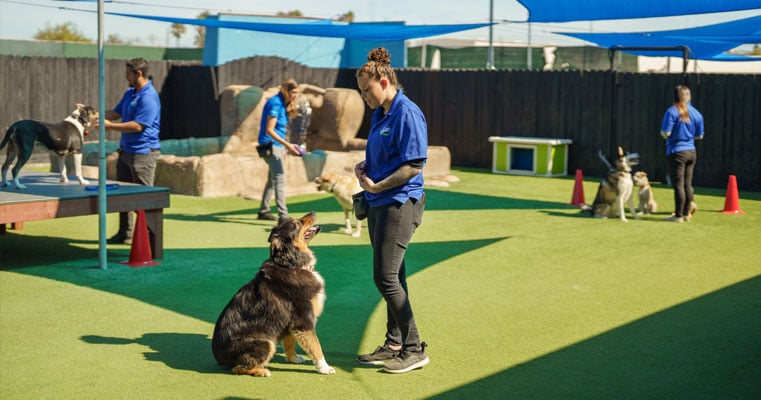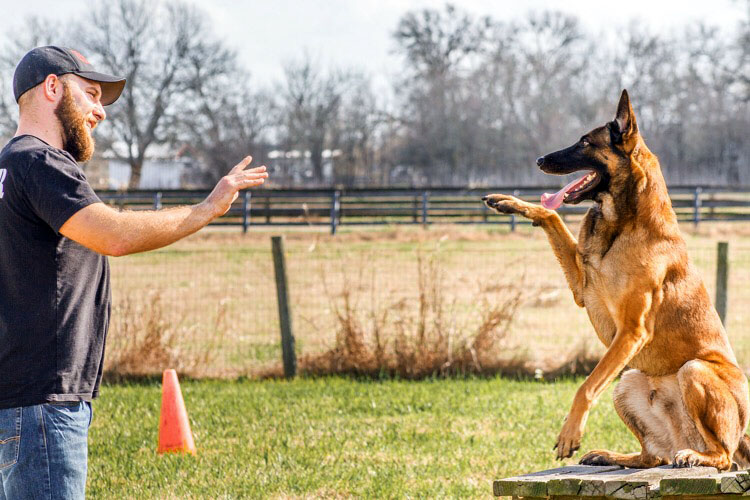The Advantages of Very Early Dog Training for a Well-Behaved Family pet
The Advantages of Very Early Dog Training for a Well-Behaved Family pet
Blog Article
Vital Tips for Effective Dog Training: A Guide for Pet Dog Owners
Effective canine training is a multifaceted procedure that needs a critical strategy customized to both the pet's personality and the proprietor's purposes. Key elements such as developing constant commands, using positive reinforcement, and assisting in early socializing play critical roles in fostering a well-adjusted canine buddy. However, lots of pet proprietors encounter obstacles that can hinder development, causing stress and unpredictability. Understanding just how to browse these barriers can dramatically enhance the training experience, ultimately changing the partnership between proprietor and dog. What are the essential techniques that can be employed to guarantee success in this undertaking?
Recognizing Canine Behavior
Understanding canine actions is important for efficient training and fostering a harmonious relationship in between canines and their owners. dog training. Dogs interact largely through body language, articulations, and actions, making it crucial for owners to translate these signals accurately.

Socialization plays a significant function in pet dog behavior; exposure to various atmospheres, people, and various other animals can substantially impact a dog's character. Moreover, elements such as breed attributes and private temperament ought to assist training techniques, as some breeds might have certain behavior attributes that demand customized strategies. By recognizing these aspects, owners can develop a helpful setting that encourages favorable behavior, resulting in successful training end results and a much deeper bond with their family pets.
Establishing Regular Commands
Efficient communication with your canine begins with developing consistent commands. This foundational component of training is important for cultivating understanding in between you and your pet. Uniformity in the commands you use makes certain that your pet dog can reliably associate particular words or expressions with the desired actions.
When picking commands, select clear, unique words that are simple to set apart and say from each other. Stay clear of utilizing similar-sounding commands that might confuse your pet dog. Making use of "rest" and "stay" is appropriate, yet "rest" and "struck" might lead to misunderstandings.
Additionally, preserve the very same tone and volume for each command. Pets are delicate to vocal cues, so differing your tone can create complication.
It is just as important to ensure that all member of the family are on the very same page regarding the commands made use of. A united front in command use will stop mixed signals and reinforce the discovering process.
Positive Support Strategies
The power of positive support in pet dog training hinges on its capacity to encourage preferred behaviors with benefits and appreciation. This technique is based in the principle that behaviors complied with by beneficial results are most likely to be duplicated. By including favorable reinforcement right into your training regimen, you can efficiently shape your canine's behavior in a useful way.
To implement positive reinforcement, it's important to recognize what inspires your canine, whether it be treats, playthings, or verbal praise. When your pet dog carries out a wanted activity, such as remaining on command, promptly award them with a treat or affection. This organization in between the command and the favorable outcome reinforces their understanding.
It's important to timing the incentives properly; supplying the support within Check Out Your URL secs of the desired actions assists your pet dog make the connection (dog training). Additionally, consistency is vital-- guarantee that all member of the family use the same commands and benefit systems to stay clear of complication

Slowly, you can reduce the regularity of treats as your pet learns the actions, transitioning to applaud or intermittent rewards. This method not only promotes a strong bond between you and your dog yet also advertises a positive learning atmosphere, making educating a delightful experience for both.
Socialization and Communication
Regularly exposing your canine to a selection of settings, individuals, and other pets is essential for their social development. Socialization needs to start early, ideally during the crucial window of 3 to 14 weeks, when young puppies are most responsive to new experiences. Nonetheless, older dogs can also profit from recurring socializing efforts.
Present your pet dog to different settings, such as parks, pet-friendly shops, and city locations. This exposure helps them adjust to numerous stimuli, lowering stress and anxiety and worry actions. Urge positive communications with various other canines and people, making certain that these experiences are controlled and safe to foster self-confidence.
Use structured playdates with genteel dogs, as this can enhance your canine's social abilities and instruct them proper actions. Obedience courses and training sessions also supply exceptional opportunities for socialization, permitting your canine to connect with others in a supervised setting.
Monitor your canine's body language throughout communications, as this will certainly assist you evaluate their convenience degree. Slowly enhance check here direct exposure to even more challenging situations while guaranteeing that each experience is positive. A well-socialized canine is much more most likely to display balanced behavior, making them a happiness to have in any type of setting.
Addressing Common Training Challenges
Every dog owner will encounter training challenges at some time, no matter their dog's age or socialization level. Determining typical problems such as stubbornness, diversions, and fearfulness can aid in creating effective approaches for enhancement.

Progressively present diversions as the canine ends up being a lot more skillful in commands. Short, regular training sessions are additionally reliable in maintaining attention.
Terror can impede a pet dog's knowing process. Progressive desensitization to the resource of concern, combined with positive reinforcement, can assist reduce anxiety. Perseverance is important; never ever require a pet dog right into a scenario that triggers distress, as this may exacerbate the problem.
Ultimately, understanding and resolving these usual obstacles with a structured strategy will certainly foster an extra effective training experience, enhancing the bond in between canine and owner while promoting efficient discovering.
Verdict
In recap, successful pet training depends on a comprehensive understanding of canine habits, the facility of constant commands, and the application of favorable support methods. Socialization plays a critical function in creating well-adjusted pet dogs, while attending to typical training obstacles calls for perseverance and versatility. By applying these necessary approaches, pet proprietors can foster a strong bond with their pet dogs and advertise preferable actions, eventually causing an unified partnership between humans and their canine companions.
Understanding canine behavior is crucial for efficient training and cultivating an unified connection in between dogs and click for info their owners.Socialization plays a significant function in pet behavior; exposure to different settings, people, and other pets can dramatically influence a dog's temperament.The power of favorable support in dog training exists in its capacity to encourage wanted habits through incentives and praise. By incorporating favorable support into your training routine, you can efficiently shape your pet dog's behavior in a useful fashion.
In recap, successful pet dog training counts on a comprehensive understanding of canine behavior, the establishment of regular commands, and the application of favorable support techniques.
Report this page